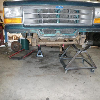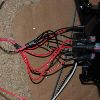richardk
Member
- Joined
- July 30, 2007
- Messages
- 12
- Reaction score
- 0
- City, State
- Aberdeen
- Year, Model & Trim Level
- 1998
OK. This is my first post so be gentle! I am sure that what I am asking for is probably simple for most people, unfortunately for me it's a bit of a nightmare!
Anyway, here's my problem. I wan't to replace the front discs and pads on my '98 explorer. I went out and bought new pads and discs and a Haynes manual. I thought this would be enough to get me started. How wrong I was! The Haynes manual guides you through all the steps except when it comes to removing the lower caliper pin. All it tells you to do is remove it but not how.
I really don't want to damage anything so any help with this would be appreciated. If anyone has a photograph of the procedure that would be even better.
Also, my explorer is left out on the driveway all the time so most of the nuts and bolts are in a bad way. Any helpful hints on how best to free rusted seized bolts?
I really would appreciate any help/advice anyone can offer.
Cheers
Richard
Anyway, here's my problem. I wan't to replace the front discs and pads on my '98 explorer. I went out and bought new pads and discs and a Haynes manual. I thought this would be enough to get me started. How wrong I was! The Haynes manual guides you through all the steps except when it comes to removing the lower caliper pin. All it tells you to do is remove it but not how.
I really don't want to damage anything so any help with this would be appreciated. If anyone has a photograph of the procedure that would be even better.
Also, my explorer is left out on the driveway all the time so most of the nuts and bolts are in a bad way. Any helpful hints on how best to free rusted seized bolts?
I really would appreciate any help/advice anyone can offer.
Cheers
Richard










